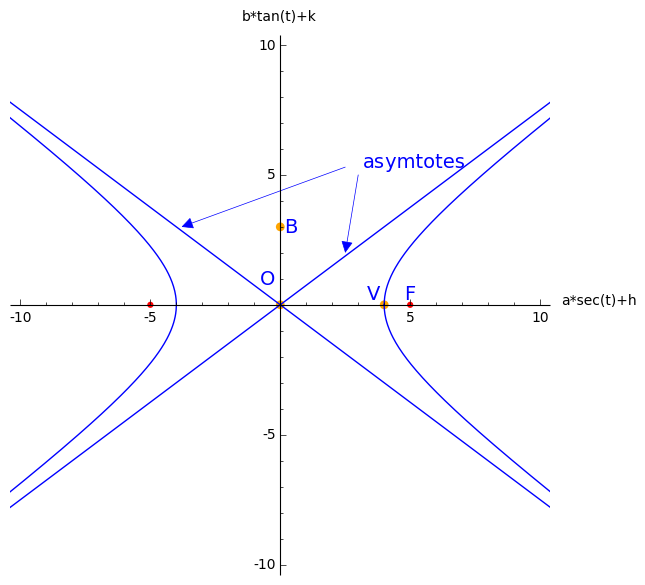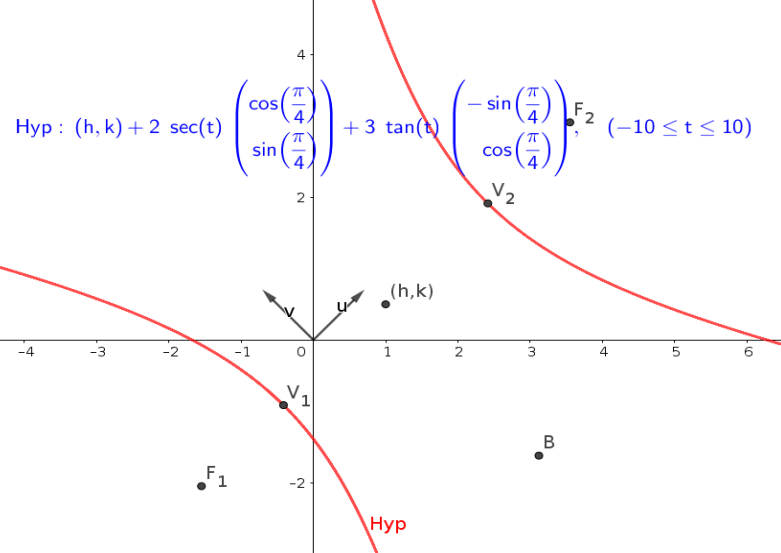Hyperbola
The hyperbola is mathematically related to the ellipse. While the two geometries do not look similar, the equations are similar and the parameters used to describe them are similar and they are both conic sections. The simple Cartesian equation of a hyperbola is $$\frac{x^{2}}{a^{2}}-\frac{y^{2}}{b^{2}}=1.$$ There is a trig identigy, $sec^{2}(t)-tan^{2}(t)=1$. If we let $$\left(\begin{array}{c} x\\ y \end{array}\right)=\left(\begin{array}{c} a\sec(t)\\ b\tan(t) \end{array}\right) \tag{1} \label{1}$$ we can substitute into $\eqref{1}$ to get $$\frac{a^{2}\sec^{2}(t)}{a^{2}}-\frac{b^{2}\tan^{2}(t)}{b^{2}}=1$$ which preserves the identity and thus is true. That strongly suggests that the parameterization is correct. To get the center offset, we add center point, $(h,k)$ just as in similar parameterizations. $$\left(\begin{array}{c} x\\ y \end{array}\right)=\left(\begin{array}{c} a\sec(t)+h\\ b\tan(t)+k \end{array}\right)$$
The ellipse has an easily understood property about any point being the sum of the distance from each foci. The hyperbola has a similar, but much less intuitive, property.
Each point on the hyperbolic curve is the distance from one focus minus the distance to the other focus.

The center of a hyperbola is the point equidistant from the two vertices. There are two branches which curve away from one another and the two legs quickly approach the asymptotes. The asymptotes are not a part of the hyperbolic equation, although the path, once away from the vertex, approaches them so closely that graphs of the branch legs accurately represent a straight line. Like the ellipse, there are the equivalent of major and minor axes, which are seen as $a$ and $b$ in the equations and have quite similar meanings for a hyperbola. The distance from a vertex to the center is $a$. The minor axis, $b$, is not represented by a visible point (one is shown labelled $B$ in figure 1, and if plotted, represents a distance that is similar to the minor axis of an ellipse. $a^{2}+b^{2}=c^{2}$ and $c$ is the distance from the center to a focus. As $b$ increases magnitude relative to $a$, the bend is less,
To find the asymtote equation, we can start with the simple hyperbola equation: $$\frac{x^{2}}{a^{2}}-\frac{y^{2}}{b^{2}}=1$$ and solve it for $y$. $$y=\sqrt{b^{2}\left(\frac{x^{2}}{a^{2}}-1\right)}$$ As $x\rightarrow\infty$, the $-1$ under the root becomes negligible and $$y=\frac{b}{a}x.$$ To get it representative of any center point, we apply a translation. $$y-k=\left(\frac{b}{a}\right)\left(x-h)\right)$$ As with an ellipse, the hyperbola can be reoriented from opening right and left to opening up and down. Doing that is just a swap of $x$ and $y$. $$\frac{(y-k)^{2}}{a^{2}}-\frac{(x-h)^{2}}{b^{2}}=1$$ The parametrization, $\left(a\sec(t),b\tan(t)\right)$ is correct but for most ranges of $t$,it yields both branches of the hyperbola. There are other parameterizations that can separate the branches. In a later section we will introduce the hyperbolic functions and in particular $\cosh(t)$ and $\sinh(t)$. While I am not a fan of looking at columns of numbers, it is instructive here. The hyperbola can also be parametrized as $$\left(\begin{array}{c} x\\ y \end{array}\right)=\left(\begin{array}{c} a\cosh(t)\\ b\sinh(t) \end{array}\right).$$ If we look at a comparison table we can see that the secant:tangent parametrization jumps back and forth between branches, as is evidenced by the negative numbers in the $\sec(t)$ column, while the cosh:sinh parametrization is always on the right side branch.
| t | x=sec(t) | y=tan(t) | x=cosh(t) | y=sinh(t) |
| -5 | 3.5253 | 3.3805 | 74.2099 | -74.2032 |
| -4 | -1.5299 | -1.1578 | 27.3082 | -27.2899 |
| -3 | -1.0101 | 0.1425 | 10.0677 | -10.0179 |
| -2 | -2.403 | 2.185 | 3.7622 | -3.6269 |
| -1 | 1.8508 | -1.5574 | 1.5431 | -1.1752 |
| 0 | 1 | 0 | 1 | 0 |
| 1 | 1.8508 | 1.5574 | 1.5431 | 1.1752 |
| 2 | -2.403 | -2.185 | 3.7622 | 3.6269 |
| 3 | -1.0101 | -0.1425 | 10.0677 | 10.0179 |
| 4 | -1.5299 | 1.1578 | 27.3082 | 27.2899 |
| 5 | 3.5253 | -3.3805 | 74.2099 | 74.2032 |

Regardless of which parametrization is used, we can rotate the hyperbola or offset it just as we would any other conic, using basis vectors. For a rotation of $45^{\circ}$ we can set $\mathbf{u}=\left(\cos(\pi/4),\sin(\pi/4)\right)$ and $\mathbf{v}=\left(-\sin(\pi/4),\cos(\pi/4)\right)$ and write $$\left(\begin{array}{c} x\\ y \end{array}\right)=\left(\begin{array}{c} h\\ k \end{array}\right)+a\sec(t)\cdot\mathbf{u}+b\tan(t)\cdot\mathbf{v},\quad-10\le t\le10$$